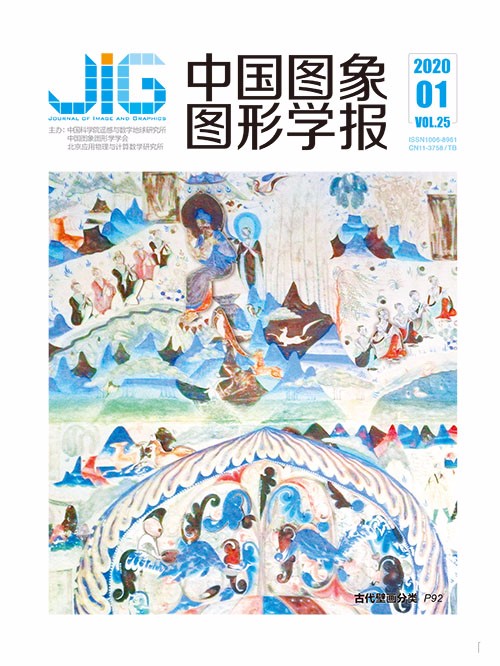
结合块旋转和马赛克拼图的生成式伪装方法
摘 要
目的 搜索式无载体信息隐藏容量低,涉及大量载体密集传输;纹理合成无载体隐藏只能生成简单质地的纹理图像;马赛克拼图信息隐藏尽管能产生有意义图像,但需修改嵌入参数。针对以上问题,提出一种结合块旋转和马赛克拼图的生成式伪装方法。方法 将灰度图像进行圆形化并添加随机转角构建马赛克,通过随机坐标决定秘密信息的隐藏位置;在隐藏位置,根据密钥和放置位置来放置代表秘密比特串的圆形图像和施加认证转角,对于非隐藏位置则放置最接近圆形图像来掩盖秘密信息;将放置过程产生的偏差通过误差扩散分散给周围未处理像素。在提取时,结合质心旋转匹配提取秘密比特并进行转角认证。结果 采用圆形图像表达秘密信息而不涉及修改式嵌入,通过马赛克拼图产生有意义含密掩体,可通过质心旋转匹配提取秘密比特并进行转角认证。对密钥严格依赖,在遭受质量因子为50~80的JPEG压缩和随机转角攻击时,秘密信息可完整恢复,在遭受强度为8%~20%的椒盐噪声攻击时,提取信息的误码率低于5%,且对秘密信息的认证成功率均在80%以上。结论 所提方法具有较好的抗攻击能力,可抵御信道攻击且具备较高的安全性。
关键词
Generative camouflage method combined with block rotation and photo mosaic
Wang Yang, Shao Liping, Lu Hai(School of Computer Science, Shaanxi Normal University, Xi'an 710119, China) Abstract
Objective Traditional search-based coverless information hiding usually searches natural and unmodified carriers that contain appropriate secret vectors to transmit secret information. However, for natural images and texts, the ability to express irrelevant secret information is low. Thus, the hidden capacity is low. Search-based coverless information hiding cannot avoid the dense transmission of massive carriers that attract attacks easily and results in distorted secret information. Texture-based coverless information hiding usually divides sample texture image into several blocks, creating the mapping relationship between texture blocks and secret segments. Although such methods generated stego texture images by sample texture synthesis, they can only generate simple unnatural texture images. Mosaic-based information hiding can generate meaningful stego images, but in essence, such methods are modification-based information hiding, and they inevitably leave modification traces in carriers and have no authentication strategy. Therefore, verifying the authenticity of recovered secret information is impossible. Moreover, mosaic-based information hiding typically uses the LSB(least significant bit)-based modification embedding strategy for a large embedding capacity to embed the transformation parameters. The LSB-based embedding strategy is sensitive to attacks, and the embedded information is easily lost when suffering attacks. To address these problems, this study proposed a generative camouflage method combined with block rotation and photo mosaic. Method In the embedding, the proposed method transformed grayscale images into circle images with pseudo-random angles by user keys to construct photo mosaics and then generated random integer coordinate sequence to determine the hidden positions of secret bit strings. For each hidden position, a circle image related to user key and position was placed to express secret bits, and then the random angle related to user key and position was added for authentication. For each non-hidden position, a circle image similar to cover image pixel was set to conceal the secret image, and the added random perturbation angle precluded distinguishing hidden and non-hidden positions. The deviation caused by the placement of the circle image was scattered around unprocessed pixels by the error diffusion method to form the stego photo mosaic image. In the extraction, coordinates for all secret bits in the stego photo mosaic image were obtained by user key, and circle images expressing secret bits were fetched. The centroid of each circle image that expresses secret bits was normalized into the right half-axis and then identified by the strategy of centroid rotation matching. Each circle image index was found to extract the hidden secret bits by the minimum quadratic difference distance. To authenticate the correctness of each circle image fetched secret bits, the factual and theory angles were compared, where the minimum quadratic difference distance of the factual angle, and the theory angle was computed by the user key, and the fetched secret bits. If the factual angle equals the theory angle, then the extracted secret bits are correctly recovered. Result The proposed method regards each circle image as a hidden unit and only involves the rotation of circle images without any modification. The added random rotation angles also provide the security assurance for the specific user to extract secret information and conduct angle authentication. Only the user with the correct user key can eliminate the influence of random rotation angles and extract the correct secret information with its corresponding authentication information. Moreover, the proposed method uses photo mosaic to hide secret information. The method is robust in anti-attacks and has good authentication accuracy. At the same time, the proposed strategy relies entirely on the user's key and has high security. The experiments show that secret information can be completely recovered only by the correct key. Whether one or more user key parameters are changed, the changed user key parameters lead to the inaccurate extraction of secret information. In addition, in case of JPEG compression attacks with a quality factor of 50~80 and random rotation angle attacks, the embedded secret information can be completely recovered. Even with salt-and-pepper noise attacks of 8%~20%, the error rate(ER) of extracted information remains approximately 5%. The authentication success rates of the restored information are all above 80%. Conclusion The proposed method uses randomly placed circle images to express secret information without any modification. The method can use photo mosaic to generate meaningful hidden carrier images and avoid the high cost of database creation and searching of the search-based coverless information hiding. The proposed method combines the parameter mapping and error diffusion mosaic image generation strategy to place stego circle images in their corresponding positions and then generate the stego mosaic image, avoiding the dense transmission of massive carriers in search-based coverless information hiding. Compared with the texture-based coverless information hiding, the proposed method can generate meaningful stego photo mosaic images, avoiding the generation of meaningless texture images in texture-based coverless information hiding. Even during attacks, each circle image expressed secret bits and its placement angle are not easily lost. The proposed method can extract secret information by centroid rotation matching and random rotation angle strategy based on user keys and improve the accuracy of secret information recognition.
Keywords
photo mosaic coverless generative hiding centroid rotation matching error diffusion random angular authentication
|



 中国图象图形学报 │ 京ICP备05080539号-4 │ 本系统由
中国图象图形学报 │ 京ICP备05080539号-4 │ 本系统由